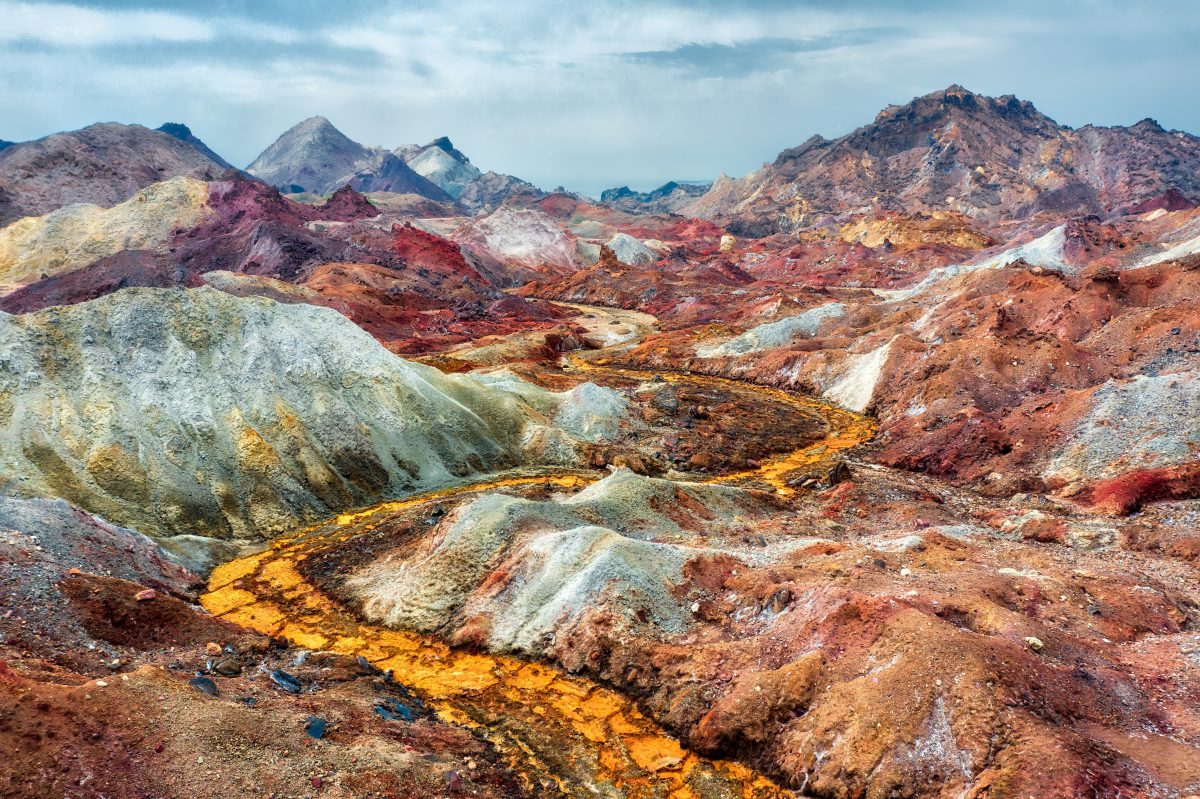Table of Contents
Nestled in the heart of Hormuz Island lies a geological wonderland that defies imagination. The Colorful Mountains of Hurmoz Island, also known as Rainbow Valley, stand as a testament to nature’s artistic prowess, painting the landscape with an astonishing palette of over 70 mineral hues. This mesmerizing spectacle of Colorful Mountains stretches across much of the island’s interior, inviting visitors to wander freely through a living canvas of reds, purples, yellows, and blues.
While the entire island boasts colorful terrain, the area near Silence Valley offers an especially concentrated display of chromatic brilliance. Here, the earth itself becomes a subject of scientific fascination, drawing geologists from around the world to study its unique mineral composition. As you traverse the undulating terrain, each step reveals new shades and patterns, creating an ever-changing panorama that seems almost too vibrant to be real. The Rainbow Mountains and Valley aren’t just a feast for the eyes – they’re a natural laboratory, offering insights into the complex geological processes that have shaped this remarkable island over millions of years.
Mineral Colors of Colorful Mountains
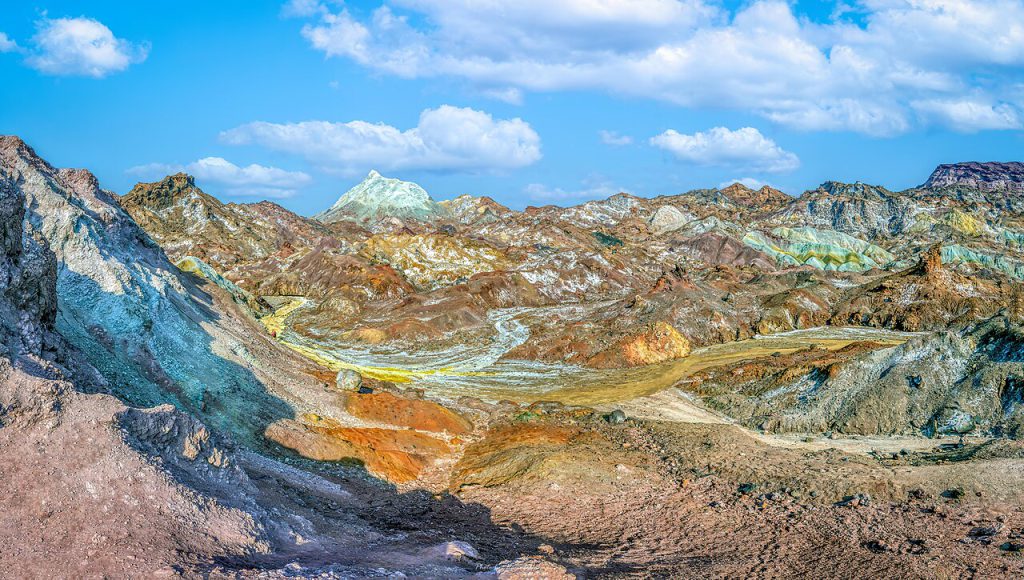
Hormuz Island, often referred to as the “rainbow island,” boasts a breathtaking array of colors that captivate the senses and stir the imagination. The landscape is a striking canvas painted with hues of ochre, crimson, and gold, each shade telling a tale of the geological forces that shaped this unique environment. The island’s mineral-rich soil, primarily composed of iron oxide, creates a vivid tapestry across its rugged cliffs and sandy beaches. Visitors are treated to a sensory spectacle, where every step reveals new colors and textures, from the shimmering salt crystals that adorn the walls of enchanting caves to the vibrant red earth that locals use in culinary delights and artistic expressions.
As one traverses the colorful highlands, the interplay of sunlight and shadow enhances the island’s natural beauty, transforming it into a living art gallery. The geological history of Hormuz is as fascinating as its appearance; millions of years of volcanic activity and erosion have sculpted its terrain into fantastical shapes, reminiscent of mythical creatures. Each corner of this geological marvel offers a glimpse into the Earth’s dynamic processes, inviting travelers to ponder the intricate relationship between nature and art. The ethereal beauty of Hormuz Island not only enchants visitors but also serves as a reminder of the importance of preserving such irreplaceable landscapes for future generations.
Colorful Mountains: The Geological Wonders
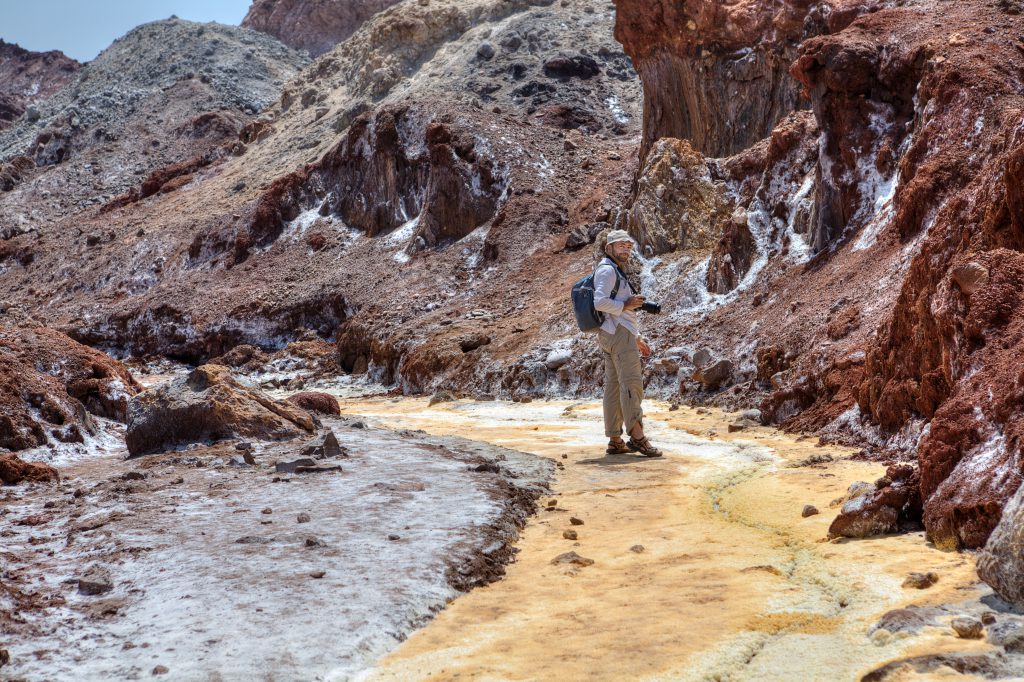
Colorful Mountains or Rainbow Valley is a mesmerizing spectacle that captivates geologists, artists, and nature enthusiasts alike. Envision a narrow valley where the earth and sand burst into a kaleidoscope of colors, with mountains painted in shades of red, purple, yellow, ochre, and blue. This stunning palette is the result of the uneven cooling of molten rock, creating a natural masterpiece that seems almost otherworldly. The valley’s vibrant hues form geometric patterns that are both awe-inspiring and photogenic, especially in the late afternoon when the light enhances the colors’ brilliance.
The geological marvels of Rainbow Valley are not just a feast for the eyes but also a testament to the Earth’s dynamic processes. The multi-hued landscape, sculpted by natural erosion, offers a unique glimpse into the planet’s volcanic history. Each patch of color tells a story of mineral deposits and geological transformations, making it a living canvas that evolves with time. This natural wonder invites visitors to explore its vivid terrain, providing endless inspiration for artists and photographers who seek to capture its ephemeral beauty.
How to Get to Colorful Mountains
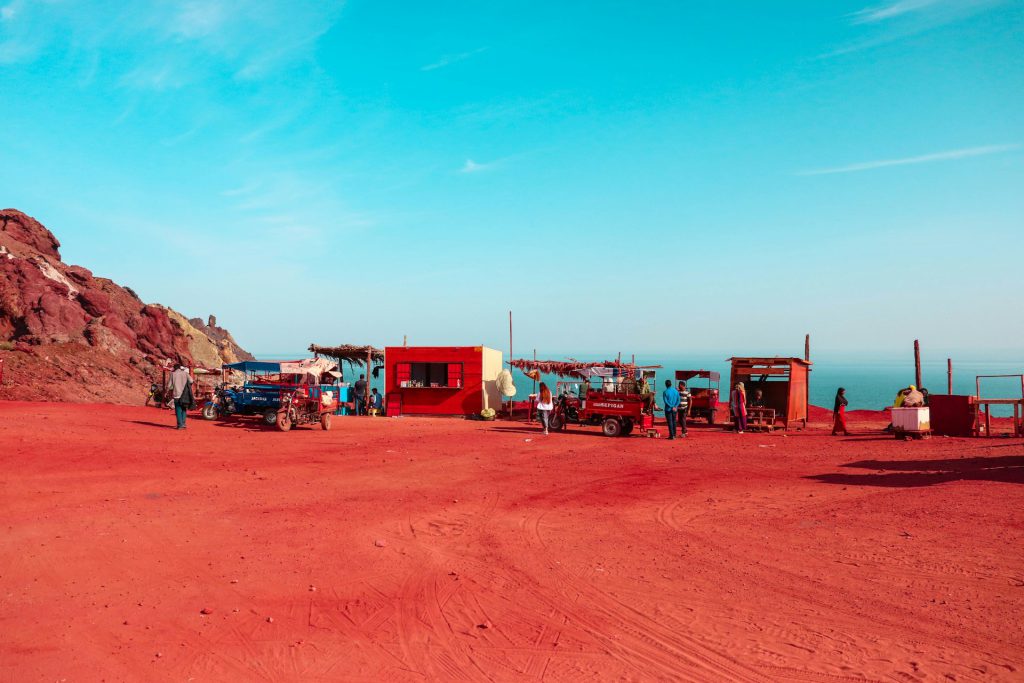
To embark on an unforgettable journey to Hormoz Island’s famed Colorful Mountains, start by crossing the sparkling Persian Gulf.
If you’re departing from Bandar Abbas, make your way to Shahid Haqqani Wharf, where a ferry will whisk you away to Hormoz in about 45 minutes. The ferry ride itself is a scenic introduction to the vibrant adventure ahead, offering breathtaking views of the Gulf’s azure waters.
If you’re traveling from Qeshm Island, head to Zakeri Wharf, where regular boats set sail for Hormoz, with a journey time of around 50-60 minutes.
Exploring Hormoz by Tricycle
Upon arrival on Hormoz Island, the real excitement begins as you set off to explore the Colorful Mountains. Hop on one of the island’s charming tricycles, a perfect way to traverse the island’s stunning landscapes. As you pedal through winding trails, the vivid hues of the mountains come into view, painting a surreal picture of reds, oranges, and purples against the desert backdrop. The tricycle ride not only offers an up-close experience of these geological wonders but also allows you to absorb the island’s unique atmosphere, making the journey as memorable as the destination.
Best Time to Visit Colorful Mountains
The best time to explore the vibrant, colorful mountains of Hormoz Island is between October and February when the weather is refreshingly mild. This period offers the perfect backdrop to immerse yourself in the island’s unique geological wonders, including the mesmerizing mountains formed from 90 different shades of soil.
The cooler climate allows you to truly appreciate the vivid hues that stretch across the landscape without the intense heat of other months weighing you down.
Other Attractions in Hormoz Island
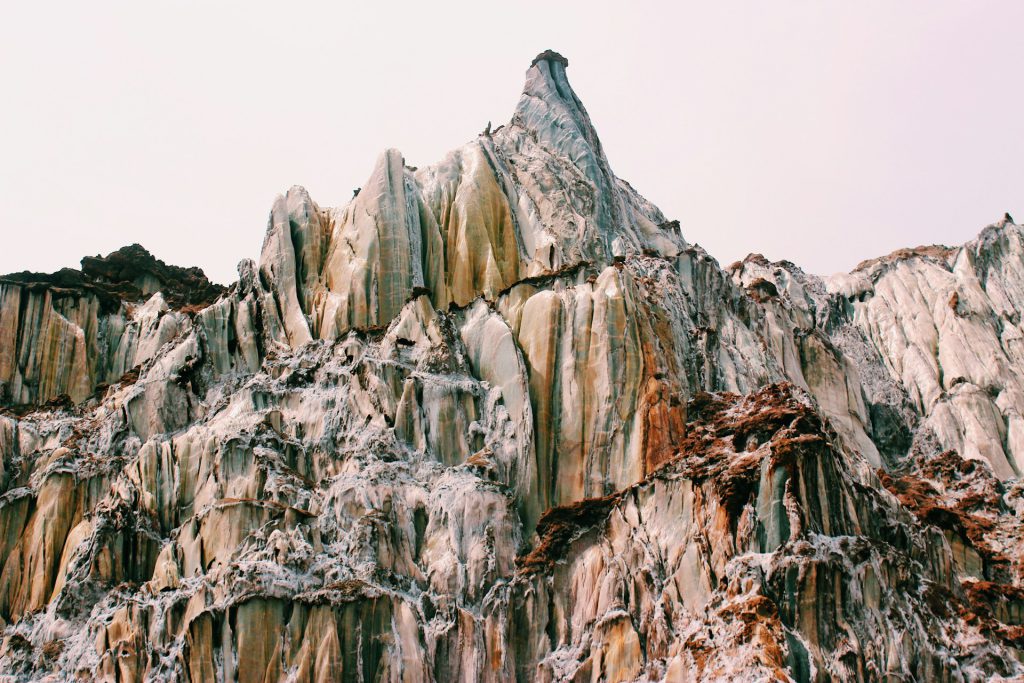
Salt Goddess
On the enchanting Hormoz Island, the Salt Goddess stands as a stunning testament to nature’s artistry. This crystalline salt mountain, with its vibrant textures and formations, captures the imagination of all who visit. As you approach this geological marvel, the sheer beauty of the salt crystals, shaped over time by natural forces, becomes apparent. Visitors are often drawn to the shimmering white and colorful hues that dance across the surface, creating a breathtaking spectacle that beckons exploration.
Valley of the Statues
The Valley of the Statues, nestled along the southwestern coast of Hormuz Island, is a mesmerizing natural wonder that captivates visitors with its surreal rock formations. Shaped by millennia of wind and water erosion, these peculiar stones have taken on fantastical forms that ignite the imagination. As you wander through the valley, you’ll encounter rocks resembling everything from majestic dragons and birds of prey to playful sheep and roosters. The crystalline sands lining the path add an ethereal quality to the landscape, creating a truly otherworldly atmosphere.
Valley of the Statues
The Valley of the Statues, nestled along the southwestern coast of Hormuz Island, is a geological wonderland that captivates visitors with its surreal rock formations. Carved by centuries of wind and water erosion, these striking stone sculptures have taken on fantastical forms that ignite the imagination. As you wander through the valley, you’ll encounter rocks resembling everything from majestic dragons and birds of prey to playful sheep and roosters, each one a testament to nature’s artistic prowess.
FAQs about Colorful Mountains
Q1: Where is Hormuz Island located?
A1: Hormuz Island (pronounced as “hor-mooz”) is an island located in Iran, in the Persian Gulf. It is situated in the Strait of Hormuz, about 8 kilometers (5 miles) off the coast of Iran, and is part of Hormozgan Province.
Q2: Why is Hormuz Island colorful?
A2: Hormuz Island is located about 8 kilometers off the coast of Iran, in the blue waters of the Persian Gulf. It has a pear-like shape and is made of a salt dome, which is embedded in layers of shale, clay, and volcanic rock containing iron. This gives the island bright colors of red, yellow, and orange, due to the more than 70 different minerals found there.
Q3: What is the story behind Rainbow Mountain?
A3: The Rainbow Mountain gets its colorful appearance because of the minerals in the soil. During ancient times, when the area was covered in water, the minerals were carried away by the flowing water. Over a long period, these minerals settled on top of each other, creating layers of different colors. The arrangement of the colors depends on the weight of each mineral.
Q4: What is the colorful island in Iran?
A4: Hormuz is an island located in the Persian Gulf, about 20 kilometers southwest of the city of Bandar Abbas. The island is most well-known for its colorful soil, which is why it has the nickname “the Colorful Island”. You might be surprised to see the handicrafts made entirely from this local soil!
Q5: Does Iran have a red beach?
A5: The beaches on Hormuz Island in southern Iran are typically red in color, even when the weather is not hot. This is because the soil on the island contains high amounts of a natural mineral called iron oxide.
Last Words: Explore the Best of Colorful Mountains with a Customized Tour
The Colorful Mountains or Rainbow Mountains and Valley on Hormuz Island are a stunning natural wonder. The landscape is painted with over 70 different mineral colors, creating a breathtaking display of reds, purples, yellows, and blues. This colorful area covers much of the island’s interior, inviting visitors to explore the living “canvas” of vibrant hues.
If you’re eager to witness the stunning Colorful Mountains and Valley of Hormuz Island, a customized and tailored tour is the best way to experience the very best of Iran’s natural beauty. When you book with To Iran Tour, we work closely with you to understand your travel goals, budget, and personal style. From there, we curate a customized tour that maximizes your time and ensures you see the most iconic sites, as well as hidden gems that only a local expert would know.
So, if you’re ready to embark on a journey that will leave you awestruck and inspired, let To Iran Tour be your guide to the vibrant and captivating heart of Iran.

